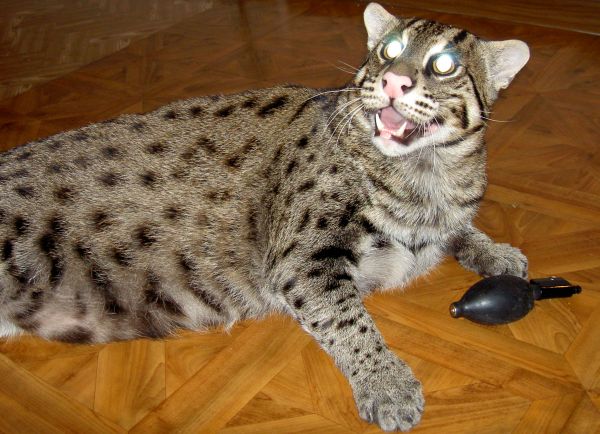
Fishing cat(Felis viverrinus)
Phylum —chordata
Class — mammalia
Order — сarnivora
Family — felidae
Genus – prionailurus
Appearance
Its coarse fur is olive-grey to ashy-grey with darker stripes on the shoulder and roundish or oval-shaped spots on the flanks and sides. The short and rounded ears are set low on the head, and the back of the ears have a white spot. Two stripes are on the cheeks, and four stripes run from above the eyes between the ears to the shoulder. The underside is white, and around the throat are two rows of spots. The tail is short, less than half the length of head and body, spotted at the base and with a few black rings at the end. The underside fur is longer and often overlaid with spots. It is about twice the size of a domestic cat and stocky and muscular with medium to short legs. Its face is elongated. Its head-to-body length typically ranges from 57 to 78 cm (22 to 31 in), with a tail of 20 to 30 cm (7.9 to 11.8 in). Female fishing cats range in weight from 5.1 to 6.8 kg, and males from 8.5 to 16 kg.
Habitat
The fishing cat is broadly but discontinuously distributed in Asia, and is primarily found in the Terai region of the Himalayan foothills in India and Nepal, in eastern India, Bangladesh and Sri Lanka.
Behavior
The fishing cat is thought to be primarily nocturnal, and is very much at home near water. It can swim long distances, even under water. Adult males and females without dependent young are solitary.
They mark their territory using cheek-rubbing, head rubbing, chin rubbing, neck rubbing and urine-spraying to leave scent marks. They also sharpen their claws and display flehmen behavior.
Diet
Fishing cats have been observed while hunting along the edges of watercourses, grabbing prey from the water, and sometimes diving into the water to catch prey further from the banks. Their main prey is fish; scat collected in India's Keoladeo National Park revealed that fish comprises approximately three-quarters of their diet, with the remainder consisting of birds, insects, and small rodents. Mollusсs, reptiles including snakes, amphibians and carrion of domestic cattle supplement their diet.
Reproduction
Wild fishing cats most likely mate during January and February; most kittens in the wild were observed in March and April. In captivity, the gestation period lasts 63–70 days; females give birth to two or three kittens. They weigh around 170 g (6.0 oz) at birth, and are able to actively move around by the age of one month. They begin to play in water and to take solid food when about two months old, but are not fully weaned until six months old. They reach full adult size when about eight and a half months old, acquire their adult canine teeth by 11 months, and are sexually mature when approximately 15 months old.
In captivity
Fishing cat lives up to 10 years in captivity.
The best way to gain an animal`s respect is to hand-feed it since its childhood. So it will know that having you nearby is safe for it.
It is prohibited to play “fighting with an arm or a foot” with a kitten. It is better to use toys otherwise getting mature it will think that your own arms and feet are toys, it will bite and scratch them. It is recommended to play with a cat in the bathroom or in the swimming pool using “swimming” toys.
It is prohibited to shout at the cat or to beat it. For example, if it constantly climbs your dining table it should be punished by a spray or an air pump. You should say, ‘Don`t do it!” and blow hard. The catwill learn a lesson quickly and in the futurea verbal command will be enough.
If playing a cat scratches or bites you, you should leave it alone. It will soon understand that it does something wrong if it is alone. These animals are very smart and require training as dogs do.
It is important all the family members pay attention to the cat. You are its parents, its flock where it is safe and it is grateful for it.
It is necessary to teach a cat to use a toilet with a filler (desirably with a wood one). If it pooped in the wrong place you shouldn`t scold at it, you should give a verbal explanation and show the right place.Keep its toilet clean.
It is necessary to vaccinate Fishing cats as domestic cats. But you should be sure that the vaccination is of a good quality and does not contain active viruses. Otherwise your pet may fall ill and die. It is very important. Your pet can`t explain you what it hurts that`s why if you pay attention to its strange behavior and to the strange way it moves you must take it to the vet immediately.
Its diet consists of some fish and raw meat with bones – poultry and beef (for example, chicken and quail thighs, wings, hearts, liver, cervixes). It`s preferably to add special vitamins with calcium supplements. Grownup cats eat from 0.45 up to 1.36 kilos of meat and fish per day.
 Russian
Russian
 English
English























